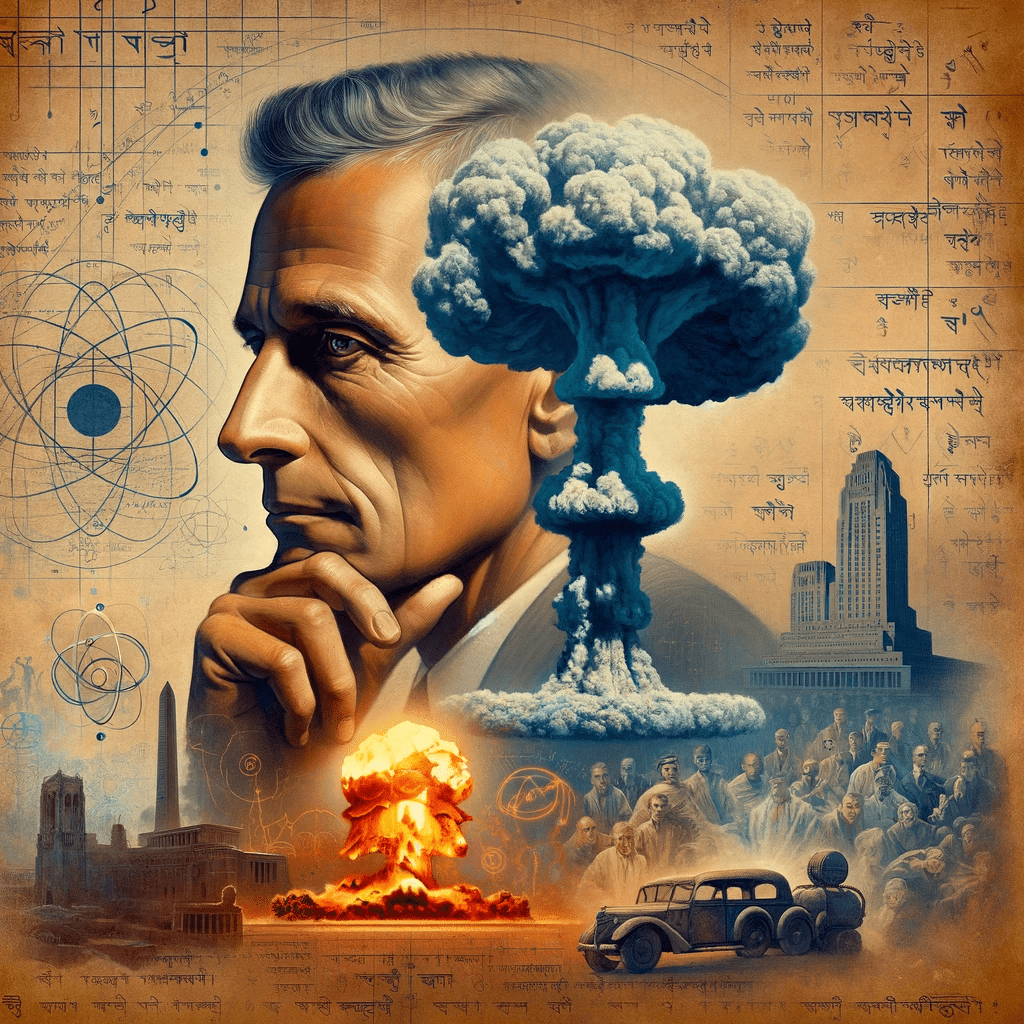Robert Oppenheimer

J. Robert Oppenheimer (1904 – 1967) was an American theoretical physicist and the scientific director of the Manhattan Project, the World War II effort by the US to develop the first nuclear weapons. Born to a wealthy family in New York City, Oppenheimer’s interest in science was sparked at an early age.
J. Robert Oppenheimer was born into a prosperous family. His father, Julius Oppenheimer, was a successful textile importer who had immigrated to the United States from Germany. His mother, Ella Friedman, was an artist. The family lived in a spacious apartment overlooking the Hudson River, and they also owned a holiday home in Long Island.
The Oppenheimers were well-off enough to provide their son with a quality education and to foster his early interest in science. They afforded him private schooling, trips to Europe, and a personal mineral collection, which sparked Oppenheimer’s initial interest in geology and physics
Oppenheimer began his formal education at the Ethical Culture Fieldston School, a private establishment in New York City known for its progressive education system. A prodigious student, he entered Harvard University in 1922, where he majored in Chemistry, graduating summa cum laude in just three years. Subsequently, he sailed across the Atlantic to study at the University of Cambridge’s Cavendish Laboratory in England under the guidance of the revered J.J. Thomson. He eventually moved to the University of Göttingen in Germany to study under Max Born, earning his PhD in 1927.
Returning to the United States, Oppenheimer held professorial positions at both the University of California, Berkeley, and the California Institute of Technology. His academic work primarily focused on quantum mechanics and particle physics, making significant contributions to the understanding of cosmic rays and electron-positron theory.
During World War II, he was appointed as the scientific director of the Manhattan Project at the Los Alamos Laboratory in New Mexico. His role was pivotal in bringing the project to its successful conclusion with the Trinity test in 1945, which marked the world’s first atomic bomb detonation.
Oppenheimer is also known for his regret over the development of atomic weapons. Following the bombing of Hiroshima and Nagasaki, Oppenheimer expressed remorse about the destructive power that he had helped unleash. According to “American Prometheus: The Triumph and Tragedy of J. Robert Oppenheimer” by Kai Bird and Martin J. Sherwin, he reportedly stated to President Truman, “Mr. President, I have blood on my hands.”
J. Robert Oppenheimer, often referred to as the “father of the atomic bomb” for his role in leading the Manhattan Project, was indeed caught up in the fervor of McCarthyism. During the late 1940s and early 1950s, he was accused of having communist sympathies, largely due to some of his previous associations and his opposition to the development of the hydrogen bomb. In 1954, after a controversial security hearing, his security clearance was revoked. While this action did not technically constitute a “blacklisting,” it had a similar effect, as it seriously damaged Oppenheimer’s reputation and hindered his ability to work on government-related projects.
Edward Teller and J. Robert Oppenheimer, both notable physicists, worked together during the Manhattan Project, the U.S. government project during World War II that led to the creation of the atomic bomb. Their relationship, however, was marked by professional disagreements and personal tensions.
Teller advocated for the development of a thermonuclear weapon, or hydrogen bomb, which was a more powerful weapon than the atomic bomb. He was known for pushing this idea even during the Manhattan Project when the focus was on atomic weaponry. Oppenheimer, on the other hand, had concerns about the ethical implications of creating such a powerful weapon and was more hesitant about the hydrogen bomb project.
Their professional relationship worsened significantly during the early 1950s when Oppenheimer’s security clearance was under review. Oppenheimer had come under suspicion due to alleged associations with communist organizations in the past, and a hearing was held to determine whether his security clearance should be revoked. During this hearing, Teller testified against Oppenheimer, stating that he would feel “more secure” if the government did not grant Oppenheimer security clearance. This testimony was damaging to Oppenheimer and contributed to the revocation of his security clearance, an action that effectively ended Oppenheimer’s role in government and scientific advisory work.
Oppenheimer became an influential figure in U.S. science policy after World War II. He served as the chairman of the General Advisory Committee of the newly formed Atomic Energy Commission from 1946 until his security clearance was revoked in 1954. As part of his responsibilities, he provided advice on nuclear policy and research.
Albert Einstein and Robert Oppenheimer first met in 1932 at the California Institute of Technology (Caltech) during Einstein’s worldwide tour. This meeting was the start of an ongoing professional relationship, with both later becoming colleagues at the Institute for Advanced Study in Princeton. Oppenheimer once remarked that they were “something of friends,” though they had differing views on certain scientific theories, particularly quantum mechanics.
Oppenheimer became the director of the Institute for Advanced Study in Princeton in 1947, a role he held until 1966. Albert Einstein joined the Institute for Advanced Study in Princeton, New Jersey, in 1933. He moved to the U.S. after fleeing Germany due to the rise of the Nazi regime. Einstein remained at the Institute for the rest of his life, focusing on theoretical research, including his work on a unified field theory. The Institute became his intellectual home, where he worked until his death in 1955
One unique fact about Oppenheimer is that he was an ardent lover of Sanskrit literature. According to the book “J. Robert Oppenheimer: Shatterer of Worlds” by Peter Goodchild, he learned Sanskrit and read Hindu scriptures, particularly the Bhagavad Gita, whose philosophy deeply impacted his life and work.
The Bhagavad Gita, a 700-verse Hindu scripture, is part of the Indian epic Mahabharata. It consists of a conversation between Prince Arjuna and the god Krishna, who serves as his charioteer. This conversation occurs on the battlefield just before the Kurukshetra War, where Arjuna is filled with moral dilemma and despair about fighting in the war. In this text, Krishna provides Arjuna with guidance on duty (dharma) and the paths to spiritual enlightenment.
The line “Now I am become Death, the destroyer of worlds,” which Oppenheimer famously quoted, is Krishna’s description of himself when revealing his universal form to Arjuna (Chapter 11, verse 32). This form embodies time, death, and destruction, showing Arjuna the inevitability of life’s cycle of birth, death, and rebirth, and the importance of fulfilling one’s duties without attachment to the outcomes.
In the context of the first nuclear explosion, Oppenheimer’s invocation of this verse was a poignant reflection of his inner turmoil. As a scientist, he had fulfilled his duty in leading the development of the atomic bomb. Yet, upon witnessing its destructive power, he seemed to recognize and empathize with the moral and ethical dilemmas that Arjuna faced on the eve of battle. The weapon he helped create had the potential for immense destruction, akin to the terrifying form of Krishna as time and death.
For Oppenheimer, the quote signified a deep ambivalence towards his creation. It signaled an acknowledgment of the bomb’s destructive power, which could annihilate civilizations akin to how ‘Death,’ in the form of Krishna, would at the end of time. It also symbolized his realization that science and technology, divorced from moral and ethical considerations, could lead to unprecedented destruction.
Given their extraordinary contributions to physics and their central roles in developing atomic theory and nuclear technology, Einstein and Oppenheimer would theoretically have been highly valuable resources at the time in any effort to understand advanced, unexplained technology such as that supposedly exhibited by UFOs. Remember Albert Einstein was specifically connected to the UFO program.
- Understanding Advanced Physics: If UFOs were to represent technology far in advance of our own, understanding the physics behind them would likely require scientists at the cutting edge of our own understanding of the universe. Einstein’s work on relativity changed our understanding of space and time, and Oppenheimer’s work on nuclear physics was directly applicable to the most advanced technology of his day.
- National Security Implications: If the UFO phenomena were perceived as a potential threat, or if they represented an opportunity to acquire advanced technology, it would make sense that top scientific minds would be called in to study the situation. During the Cold War, both scientists were already involved in national security through their work on the Manhattan Project. Einstein famously wrote a letter to President Roosevelt urging the development of an atomic bomb, and Oppenheimer was the scientific director of the Manhattan Project.
- Scientific Curiosity: Both Einstein and Oppenheimer had deep curiosity about the universe. If they had been presented with credible evidence of phenomena that couldn’t be explained by existing science, it’s possible that they might have been intrigued and motivated to investigate further.
- Government Involvement: It’s well-documented that the U.S. government has conducted investigations into UFO sightings (e.g., Project Blue Book) due to national security concerns. If the government had secret information about UFOs, it’s conceivable, though entirely speculative, that they might have recruited top scientists to help them understand it.
Albert Einstein did write a letter to President Franklin D. Roosevelt in 1939, known as the Einstein–Szilárd letter. It was actually physicist Leo Szilárd who conceived the idea of the letter and wrote a draft, but he had it signed by Einstein because of Einstein’s prominent status. The letter warned that Germany might develop atomic bombs and suggested that the United States should start its own nuclear program. It didn’t explicitly urge the development of an atomic bomb, but it led to the creation of the Advisory Committee on Uranium, which eventually evolved into the Manhattan Project.
Robert Oppenheimer was a complex and brilliant figure—a physicist, leader, and intellectual who wrestled with the ethical weight of his scientific contributions. Beyond his central role in developing nuclear weapons, Oppenheimer’s legacy also touches on broader theories. Some believe that Non Human Intelligent beings (NHIs) may have provided the technical knowledge to create nuclear weapons, further fueling discussions about UFOs being present around nuclear test sites.



